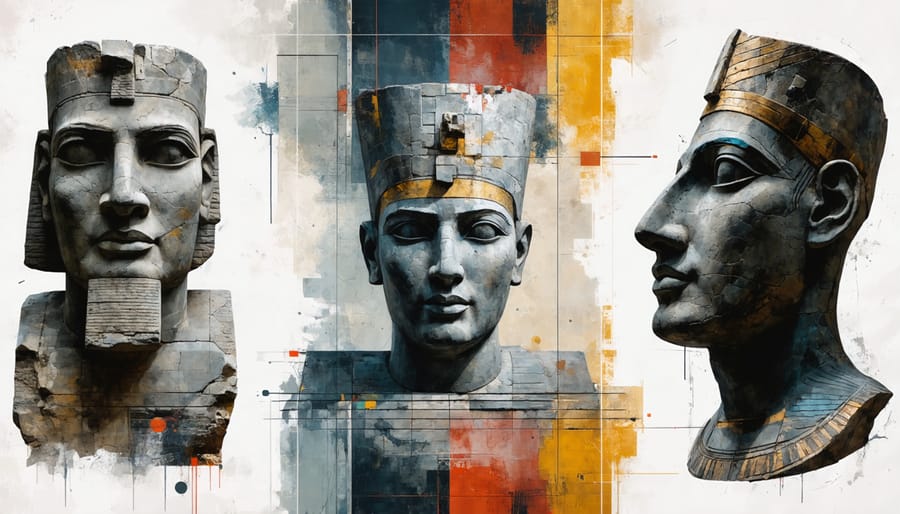Ancient stone sculptures stand as silent witnesses to humanity’s enduring quest for artistic expression and cultural preservation. From the towering moai of Easter Island to the delicate reliefs of Angkor Wat, these masterpieces carved from solid rock have survived millennia, telling stories of civilizations long past. Early artisans transformed raw stone into powerful symbols of divine authority, cultural identity, and human achievement, working with nothing more than basic tools and extraordinary skill.
These monumental works demonstrate an exceptional understanding of material properties, artistic composition, and engineering principles that continues to astound modern experts. Ancient sculptors developed sophisticated techniques for quarrying, carving, and transporting massive stone blocks, often creating works of such precision that they remain perfectly aligned despite centuries of exposure to the elements.
The practice of stone sculpture emerged independently across various ancient cultures, from the Egyptian sphinxes to Greek classical statuary, Chinese Buddhist cave temples, and pre-Columbian Olmec heads. Each civilization developed its unique artistic vocabulary while sharing remarkable similarities in technical approaches to working with stone.
What makes these ancient works particularly fascinating is not just their artistic merit, but their role as historical documents, preserving information about religious beliefs, social structures, and daily life in ancient societies. Today, these enduring monuments continue to influence contemporary artists and provide invaluable insights into human creativity and technological innovation across the ages.
The Birth of Stone Sculpture: Early Civilizations
Prehistoric Stone Carvings
The earliest examples of Stone Age art demonstrate humanity’s innate drive to create and communicate through stone. Dating back to the Paleolithic period, approximately 40,000 years ago, our ancestors began carving images into cave walls and crafting small portable sculptures from soft stones. These early works primarily depicted animals, hunting scenes, and fertility symbols, offering invaluable insights into prehistoric life.
Notable examples include the Venus of Willendorf, carved from limestone around 28,000 BCE, and the remarkable cave paintings and relief carvings at Lascaux in France. The transition to the Neolithic period brought more sophisticated stone working techniques, as humans developed better tools and established permanent settlements. This era saw the emergence of larger sculptural works and the first architectural stone carvings.
Neolithic artists began incorporating geometric patterns and increasingly complex human figures into their work. They also started using harder stones, demonstrating remarkable skill in working with challenging materials using primitive tools. The techniques they developed, such as pecking, abrading, and polishing, laid the groundwork for later sculptural traditions.
These prehistoric carvings weren’t merely decorative – they served important ritual and social functions, marking the beginning of humanity’s long relationship with stone as an artistic medium. Their influence can still be seen in contemporary stone sculpture, connecting us to our ancient creative heritage.
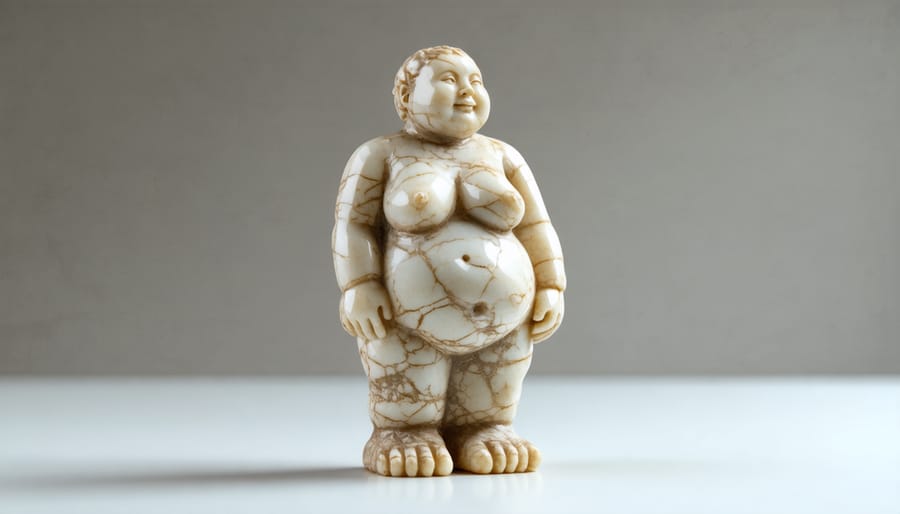
Egyptian Stone Mastery
The ancient Egyptians demonstrated unparalleled mastery in stone sculpture, creating works that continue to captivate audiences millennia later. Their remarkable Egyptian stone monuments showcase sophisticated techniques that modern craftsmen still study today.
Egyptian sculptors primarily worked with limestone, granite, and sandstone, carefully selecting materials based on their properties and intended use. They developed innovative tools including copper chisels, stone hammers, and wooden mallets to shape these challenging materials. Their method typically began with gridded guidelines drawn on stone blocks, ensuring precise proportions and symmetry in the final piece.
One of their most distinctive techniques was the subtractive method, where artists carefully removed excess stone to reveal the figure within. This approach required exceptional planning and skill, as mistakes couldn’t be corrected. The famous Great Sphinx of Giza exemplifies this technique, carved from a single limestone outcrop.
Egyptian sculptors also pioneered surface finishing techniques, using quartz sand as an abrasive to achieve remarkably smooth surfaces. They applied specialized tools to create detailed hieroglyphs and intricate relief carvings, often incorporating symbolic elements and religious imagery. These works weren’t merely decorative; they served as eternal vessels for the soul and carried deep spiritual significance in ancient Egyptian culture.
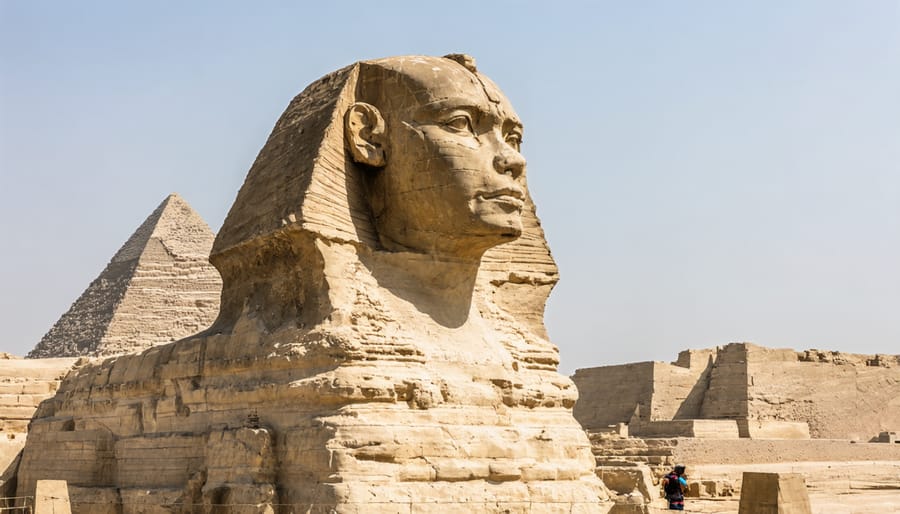
Classical Stone Artistry
Greek Stone Sculpture Revolution
The transformation of stone sculpture during ancient Greece marked a revolutionary period in art history, as craftsmen developed unprecedented techniques to capture the human form with astounding realism. During the Classical period (480-323 BCE), Greek marble sculptures evolved from rigid, formal poses to dynamic compositions that conveyed movement, emotion, and anatomical accuracy.
This artistic revolution was driven by several innovative techniques. Sculptors began using the “pointing technique,” which allowed them to transfer precise measurements from clay models to stone, ensuring greater accuracy in their final works. They also mastered the art of creating deeper undercutting and incorporating multiple viewing angles, allowing their sculptures to be appreciated from various perspectives.
The development of contrapposto – a more natural stance where the figure’s weight rests primarily on one leg – brought unprecedented realism to stone figures. This technique created a subtle S-curve in the body, making statues appear more lifelike and less rigid than their predecessors. Additionally, Greek sculptors pioneered methods for rendering different textures in stone, from the soft folds of fabric to the subtle musculature beneath the skin.
Tools also evolved during this period. Craftsmen used a variety of chisels, punches, and rasps with increasing precision, allowing them to achieve finer details and smoother surfaces. The introduction of running drills enabled them to create deeper folds in clothing and more intricate hair designs.
Perhaps most significantly, Greek sculptors developed a sophisticated understanding of human anatomy, studying living models to accurately represent the body’s underlying structure. This anatomical knowledge, combined with their technical innovations, resulted in works that appeared to capture the very essence of human movement and form, setting standards that would influence sculptural traditions for centuries to come.
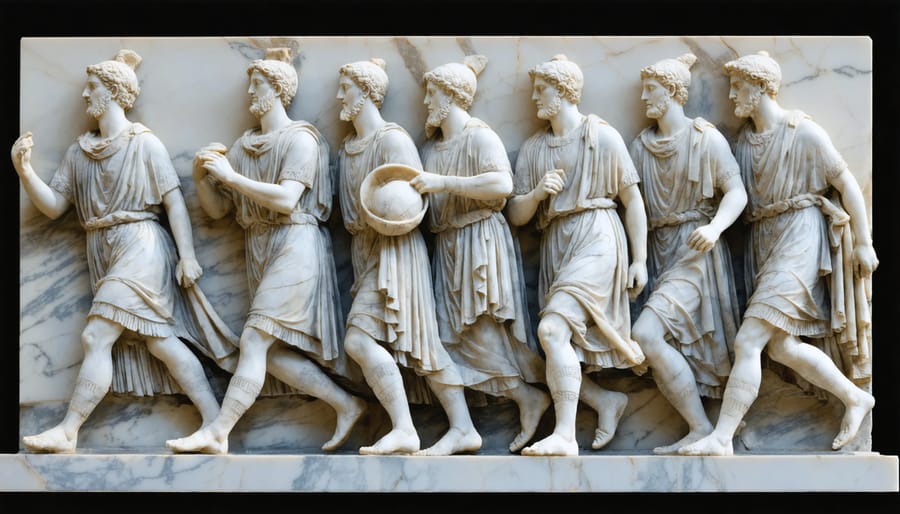
Roman Stone Legacy
The Romans revolutionized stone sculpture, elevating it beyond mere artistic expression to become an integral part of their architectural and cultural legacy. Their mastery of Roman stone artistry transformed public spaces, combining practical engineering with aesthetic beauty in ways that continue to influence modern design.
Roman sculptors perfected the art of marble carving, developing innovative techniques for achieving unprecedented levels of detail and realism. They introduced the practice of drilling deeper into stone to create more dramatic shadows and intricate folds in clothing, while their understanding of human anatomy allowed them to capture subtle musculature and lifelike expressions in their portrait busts and full-figure sculptures.
The integration of sculptural elements into architecture reached new heights during the Roman period. Elaborate friezes adorned temple facades, while decorative reliefs transformed ordinary building elements into works of art. The Romans’ mastery of concrete construction allowed them to create larger interior spaces, which they embellished with sculptural decoration that complemented the architectural design.
Their influence extended beyond aesthetic considerations to include practical innovations in stone processing and installation. Roman craftsmen developed specialized tools for quarrying and carving stone, and their methods for transporting and lifting massive blocks remained unmatched for centuries. They also pioneered techniques for creating different surface textures, from highly polished marble to roughly textured travertine, each serving specific architectural and decorative purposes.
The Romans’ greatest contribution was perhaps their standardization of sculptural practices and architectural ornamentation. This systematization allowed their artistic influence to spread throughout their vast empire, creating a unified visual language that transcended regional boundaries and established enduring principles of classical design that continue to resonate in contemporary architecture and sculpture.
Eastern Stone Sculpture Traditions
Indian Stone Temples
Indian stone temples represent some of the most remarkable achievements in architectural sculpture, showcasing intricate carving traditions that have endured for over two millennia. These magnificent structures, carved from single pieces of rock, demonstrate the extraordinary skill and patience of ancient Indian craftsmen.
The temples of Khajuraho, built between 950 and 1050 CE, display particularly sophisticated stone carving techniques, with their walls adorned with thousands of figures depicting daily life, mythological scenes, and spiritual concepts. The sculptors achieved remarkable detail in the stone, creating flowing garments, detailed jewelry, and expressive faces that appear almost lifelike despite their age.
The Ellora Caves in Maharashtra present another testament to Indian stone mastery, with the Kailasa Temple standing as its crowning achievement. Carved top-down from a single rock face, this massive structure required the removal of over 200,000 tons of stone. The precision and planning involved in such undertakings demonstrate an advanced understanding of stone properties and carving techniques.
Notable characteristics of Indian temple sculpture include the use of local granite and sandstone, multilayered relief work, and the integration of sculptural elements with architectural features. Craftsmen employed specialized tools including chisels, hammers, and measuring instruments to achieve precise geometric patterns and figurative sculptures.
The tradition continues in modern India, where contemporary artisans still practice these ancient techniques, though now aided by modern tools. These historical monuments not only serve as architectural masterpieces but also as valuable records of Indian cultural and religious heritage, preserving ancient artistic traditions through the enduring medium of stone.
Chinese Stone Mastery
Chinese stone masonry represents one of the most sophisticated and enduring traditions in sculptural history. Dating back to the Shang Dynasty (1600-1046 BCE), Chinese artisans developed unique techniques that set their work apart from other ancient civilizations. Their mastery of jade carving, in particular, demonstrated exceptional precision and patience, with single pieces often taking years to complete.
The distinctive characteristic of Chinese stone sculpture lies in its emphasis on spiritual and symbolic meaning. Artists carefully selected stones based on their natural patterns and qualities, working with rather than against the material’s inherent properties. This philosophy, deeply rooted in Taoist principles, resulted in sculptures that appeared to emerge organically from the stone itself.
Chinese masters employed specialized tools including bronze chisels, diamond-tipped drills, and abrasive sand for polishing. Their technical innovation of using rotating wheels with different abrasives allowed for unprecedented detail in their work. This technique proved particularly valuable in creating the intricate dragon motifs and Buddhist figures that dominated imperial art.
The symbolism in Chinese stone sculpture was equally sophisticated. Mountain sculptures represented the connection between heaven and earth, while animal figures carried specific meanings – tortoises for longevity, phoenixes for virtue, and dragons for imperial power. Buddhist stone carvings, such as those found in the Longmen Grottoes, showcased remarkable attention to proportion and facial expression, reflecting deep spiritual understanding.
Stone selection was crucial in Chinese sculpture. Artists preferred materials like jade, marble, and limestone, choosing specific stones based on their color, texture, and spiritual properties. This careful consideration of materials, combined with masterful technique, produced works that continue to influence contemporary stone artistry.
Materials and Methods
Stone Selection and Tools
Ancient civilizations demonstrated remarkable skill in selecting and working with various types of stone, developing sophisticated ancient stone sculpting techniques that continue to inspire modern artisans. Limestone, marble, granite, and sandstone were among the most commonly used materials, each chosen for specific properties and regional availability.
Marble, particularly prized by Greek and Roman sculptors, offered an ideal combination of workability and durability. Its fine-grained structure allowed for detailed carving while maintaining structural integrity. Egyptian sculptors favored harder stones like granite and diorite, which required greater effort to work but produced monuments of exceptional longevity.
The ancient toolset was surprisingly diverse and specialized. Basic implements included point chisels for rough shaping, flat chisels for smooth surfaces, and various hammers ranging from heavy mauls to lighter mallets. Craftsmen used bow drills for creating deeper cuts and abrasive stones for finishing touches. Archaeological evidence suggests they also employed measuring tools like plumb bobs and squares to ensure accuracy.
One fascinating aspect of ancient stone working was the use of progressive grades of abrasives. Sculptors would begin with coarse materials like quartzite sand and gradually move to finer substances such as pumice and eventually garnet dust for polishing. This meticulous process could take months or even years for large-scale works, demonstrating the extraordinary patience and precision of ancient artisans.
Today, these traditional tools and techniques provide valuable insights into historical craftsmanship, while continuing to influence contemporary stone sculpting practices.
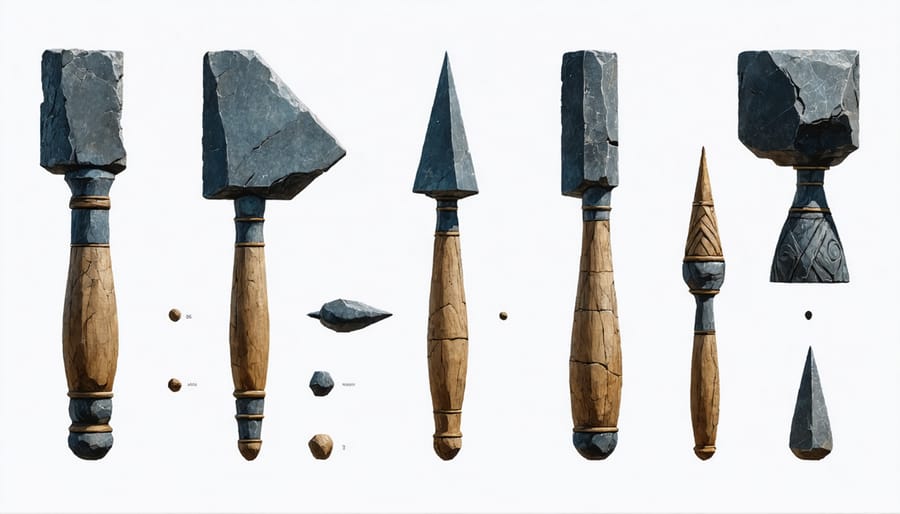
Carving Techniques
Ancient sculptors employed sophisticated techniques to transform raw stone into masterful works of art. The process typically began with the direct carving method, where artists worked directly on the stone block without preliminary models. They used a technique called “pointing” to establish key reference marks on the stone’s surface, helping them maintain proportions and depth.
The primary tools included various chisels, hammers, and picks. Large chunks were removed using point chisels and mallets, while gradually finer tools were employed for detailed work. Flat chisels created smooth surfaces, and specialized rasps and files achieved texture and finishing touches. Abrasive stones were used for polishing, often with sand and water to create a smooth finish.
Ancient Egyptian sculptors were known for their systematic approach, working from front to back in a grid system. Greek artisans developed the technique of drilling deep holes to create dramatic folds in clothing and enhanced shadow effects. Roman sculptors innovated with running drills, allowing for more intricate detail work.
One remarkable aspect of ancient carving was the ability to work without modern measuring tools. Sculptors relied on their trained eye and proportional guidelines passed down through apprenticeship. They often used the “subtractive process,” carefully removing stone while constantly reassessing the emerging form.
Evidence suggests that some cultures used copper saws with sand as an abrasive to cut through harder stones. Polishing was achieved through progressive stages, using increasingly finer abrasives, sometimes including crushed gemstones for the final lustrous finish. These time-tested techniques created works that have endured for millennia.
The legacy of ancient stone sculpture continues to resonate powerfully through contemporary art and architecture. Modern sculptors frequently draw inspiration from classical techniques and forms, adapting ancient methods to create works that speak to current audiences while maintaining a connection to our artistic heritage.
The influence of ancient stone carving can be seen in the minimalist movement, where artists embrace the raw beauty and natural textures of stone, much like their predecessors did thousands of years ago. Contemporary sculptors often employ traditional tools alongside modern technology, combining age-old chiseling techniques with digital mapping and precision cutting tools to achieve their artistic vision.
Public spaces worldwide showcase how ancient sculptural principles inform modern design. From corporate plaza installations to municipal art projects, the enduring appeal of stone sculpture demonstrates its timeless ability to enhance built environments. Museums frequently juxtapose ancient and contemporary stone works, highlighting the continuous dialogue between past and present artistic expressions.
Educational institutions continue to teach classical stone carving techniques, ensuring these valuable skills persist into the future. Many contemporary artists undertake extensive study of ancient methods, recognizing that understanding historical approaches is crucial for pushing the boundaries of modern sculpture.
The environmental sustainability of stone as a medium also appeals to contemporary artists and collectors. As society increasingly values eco-friendly materials, stone’s natural origins and durability make it particularly relevant in modern artistic practice.
Ancient stone sculpture’s influence extends beyond art into architecture, interior design, and landscape architecture, proving that these time-honored techniques and aesthetic principles remain vital in shaping our visual world today.

